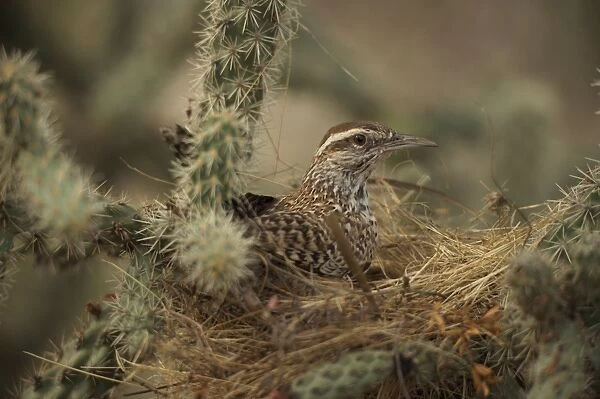Table of Contents
Significance of the Cactus Wren as Arizona State Bird
The Cactus Wren received one-of-a-kind recognition in 1931 when the Arizona State Legislature designated it as the official Arizona State Bird. This selection was not made at random; it shows the bird’s intrinsic relationship to the state’s ecology and its ability to thrive in the parched Sonoran Desert. The Cactus Wren represents Arizona’s character, representing the common perseverance and adaptability of its population.
Intriguing Facts and Characteristics
- Features: The striking black and white stripes on the cactus wren’s face, which contrast with its warm brown plumage, make it stand out as Arizona’s state bird. Its long tail, slightly curved beak, and white spots on its wings all contribute to its distinctive appearance.
- Adaptations to the Habitat: The saguaro cactus, mesquite, and prickly plants are among the many desert habitats in which the cactus wren may be found. Its magnificent nest is typically built beneath a cactus to give its young a secure haven.
- Vocal Prowess: The Cactus Wren’s captivating vocalizations match its amazing looks. This bird’s song fills the desert with a variety of melodic clicks, rattles, and chirps, serving as the background music for the dry environments it inhabits.

The Cactus Wren in the USA
Geographical Distribution
The Cactus Wren’s territory is not limited to Arizona; it includes a sizable portion of the southwest and portions of Mexico. This Arizona State Bird may be found in Texas, California, Nevada, Utah, and New Mexico since it has evolved to live in dry and semi-arid climates. Its existence adds a distinctive thread to the complex fabric of the many settings it lives in.
Habitat Preferences and Adaptations.
- Saguaro Sanctuary: The saguaro cactus is one of the unique environments that the Arizona state bird, the cactus wren, prefers. The towering arms of these recognizable cactus offer the ideal cover for the bird nests. The Cactus Wren demonstrates incredible adaptation by building elaborate nests inside the protecting spines of these enormous trees.
- Thorny Retreats: The Cactus Wren is found in areas with prickly flora scattered throughout, not only saguaros. Foraging, nesting, and predator protection, prickly plants such as creosote bushes and mesquite trees provide safe havens. This predilection for prickly havens demonstrates the bird’s skill at making the most of its environment to survive.
Unique Behaviors and Vocalizations
- Architectural Talent: The Cactus Wren is a skilled builder, creating nests that are both aesthetically pleasing and useful. These dwellings, which are made of wood, grasses, and feathers, are frequently decorated with pieces of detritus, which helps the bird blend in with its environment.
- Social Chatter: The Cactus Wren is a vibrant social butterfly that exhibits dynamic activities beyond its physically appealing appearance. These birds, who are frequently observed in couples or family groups, communicate by making a variety of noises. Their distinctive acoustic imprint in the desert air is produced by a variety of melodic chirps, rattles, and clicks that they make throughout their vocalizations.
The bird’s fascinating contribution to the biodiversity of the southwestern United States is highlighted by its wide dispersion.
Recent Developments and News
Legislative Recognition and Protection Efforts
Since politicians have been paying greater attention to Arizona’s state bird, the cactus wren, efforts to protect it have been more organized and its value has been recognized. State and federal legislators have recognized the need to safeguard the bird’s native habitat and have implemented regulations to that effect.
- Projects at the State Level: Arizona is among the southern states where legislative attempts have been made to preserve the Cactus Wren and its native environment. These activities include creating protected areas, enforcing land use laws, and educating the public about the need to preserve the ecosystem for the Arizona state bird cactus wren.
- Federal Involvement: At the federal level, agencies such as the U.S. Fish and Wildlife Service have been instrumental in developing and implementing conservation plans. These tactics place a high priority on preserving the Cactus Wren’s environment, removing threats to it, and promoting collaboration with neighboring populations in order to ensure its continued survival.
Collaborative Conservation Projects
- Community Involvement: To save the Cactus Wren, local communities, wildlife agencies, and conservation organizations have teamed together on joint initiatives. Through monitoring, reporting sightings, and taking part in habitat restoration projects, residents are engaged in community involvement initiatives.
- Habitat Restoration: Projects aimed at maintaining and improving the environments vital to the survival of the Cactus Wren are included in conservation efforts. In order to maintain the bird population, these activities entail planting native vegetation, managing invasive species, and establishing appropriate nesting locations.
Noteworthy Research and Discoveries
- Technological Advancements: With the use of GPS monitoring and remote sensing, researchers have been able to get further insight into the behavior and migration patterns of the Cactus Wren. This technique makes it feasible to identify significant ecosystems and understand how birds respond to environmental changes.
- Genetic Studies: Current genetic research has revealed important aspects of the Cactus Wren’s genetic diversity and population dynamics. These studies support the development of informed conservation plans, ensuring that programs are tailored to the particular needs of different populations.
Legislative actions, cooperation endeavors, scientific investigations, and conservation conversations are critical to ensure the Cactus Wren’s existence. The effort to preserve Arizona’s state bird, the Cactus Wren, and its unique ecological value in the southwest of the state are underscored by these most recent discoveries.
Cactus Wren Chronicles: Captivating Stories
Personal Encounters with Cactus Wrens
- Birdwatcher’s Delight: Passionate observers of the natural world frequently recount firsthand experiences with Cactus Wrens, expressing their immense joy at being able to see these endearing birds in their native range. Every meeting is made unforgettable by the Cactus Wren’s unusual sounds and vivid plumage, which create a bond between onlookers and the species’ special appeal.
- Nesting Neighbors: People who live in areas where Cactus Wrens are common often tell stories of the birds becoming beloved neighbors. Because of their clever nest-building abilities, these wrens frequently establish homes in metropolitan areas where they coexist with people. These up-close interactions provide insight into the flexibility and tenacity of these feathered friends.
Citizen Science Initiatives and Contributions
- Eyes on the Sky: Vital information on Cactus Wren populations is provided to conservation efforts by citizen scientists, who monitor these populations. These committed people actively contribute to maintaining the Cactus Wren’s well-being via reporting of nesting activity, conducting systematic bird counts, and evaluating the environment.
- Community-Led Research: Community-led research initiatives are the product of cooperative efforts between scientific institutions and local communities. Armed with their love for avian conservation, citizen scientists work on initiatives that follow the travels of Cactus Wrens, record their behavior, and gather crucial data for conservation plans.
The Cactus Wren in Local Folklore and Art
- Symbolic Significance: The cactus wren, which is the state bird of Arizona, is frequently depicted in local mythology as a representation of persistence and adaptation. Native American tribes imbue the Arizona State Bird with spiritual attributes, viewing it as a symbol of constructive transformation and fortitude in the face of hardship.
- Artistic Representations: Local artists have been inspired to adapt the Cactus Wren’s picture into many types of art because to its compelling presence. The bird’s impact may be seen in everything from traditional crafts to paintings and sculptures, honoring its status as a symbol of the Southwestern spirit.
The Cactus Wren persists in becoming an integral part of the cultural fabric of the communities it inhabits, whether it be through mutual experiences, involvement in citizen science, or the bird’s symbolic role in regional customs.
Conservation Challenges and Initiatives
Threats to the Cactus Wren Population
- Loss of habitat: The Cactus Wren’s native habitat is being threatened by urbanization and agricultural growth. With the expansion of human settlements throughout its natural habitats, the bird finds it more difficult to locate appropriate places to nest and feed.
- Impact of Climate Change: The Cactus Wren may face difficulties in obtaining resources due to the increasing effects of climate change, such as increased temperatures and modified precipitation patterns. The delicate equilibrium that keeps the bird population alive may be upset by changes in the vegetation and the availability of water.
Conservation Measures and Success Stories
- Protected Habitat identification: Conservation groups work diligently to promote the identification of protected areas critical to the survival of the Cactus Wren. By creating wildlife corridors and conservation zones, we can guarantee the availability of appropriate nesting places for birds while also preserving the integrity of their ecosystems.
- Community-driven Restoration: Projects to restore habitat are driven by communities and are an integral part of successful conservation efforts. Conservationists work to improve the general health of the ecosystem by involving local populations in the planting of native flora, the removal of invasive species, and the construction of artificial nesting places. This creates a more resilient habitat for the state bird of Arizona, the cactus wren.
- Research-Informed Policies: Research provides valuable insights into policy decisions, which in turn support conservation initiatives. In order to create successful conservation strategies and make sure that treatments are customized to the specific requirements of the Cactus Wren, ongoing research on the behavior, population dynamics, and genetic diversity of the bird is essential.
How Communities Can Contribute to Conservation Efforts
- Encouragement of Native Planting: Communities may play a proactive role in the protection of Cactus Wrens by encouraging the planting of native plants in public gardens and areas. The needs of the bird for foraging and nesting are supported when an area is planted with native plants like saguaros, mesquite, and other species.
- Reporting Sightings: Conservation efforts continue to depend heavily on citizen participation. Encouraging locals to record sightings of Cactus Wrens enables researchers to track population trends, pinpoint important locations, and evaluate the success of conservation efforts.
- Educational Outreach: Through community-based education programs, people become more aware of the value of the cactus wren and how it contributes to the preservation of ecological balance. Community conservation and bird enjoyment are fostered by workshops, school programs, and outreach initiatives.
Communities can play a crucial role in guaranteeing the survival of this unique Arizona State Bird in its native environment by working together.

Birdwatcher’s Paradise: Cactus Wren Hotspots
Top Locations for Birdwatching in Arizona
- The famous Saguaro National Park, which is split into East and West sections close to Tucson, provides excellent opportunities to see Cactus Wrens. Birdwatchers may study the nesting practices of these birds and hear their musical cries in an ideal environment made possible by the saguaro cactus-filled landscapes.
- Boyce Thompson Arboretum State Park: This arboretum, which is close to Superior, is a popular site to see Cactus Wrens because of its variety of desert plants. Trails meander through scenic environments where birdwatchers might come see these endearing birds among the verdant foliage.
Tips for Spotting Cactus Wrens in the Wild
- Early Mornings and Late Evenings: The cactus wren, which is the state bird of Arizona, is most active in the early morning and late evening. When the birds are actively foraging and interacting with one another, birdwatchers should schedule their trips around these times to have the best viewing chances.
- Keep an Ear Out for Unique Calls: Gaining identification of the Cactus Wren’s characteristic sounds increases the likelihood of seeing them. They vocalize with a variety of clicks, rattles, and melodic chirps. Birdwatchers can locate their whereabouts throughout the arid area by listening to these noises.
- Calm and Silence: The Cactus Wren is notoriously difficult to find, particularly in the breeding season. By exercising patience and remaining still, birdwatchers may view birds in their natural habitat without upsetting them. The chance of remarkable interactions rises when you choose a peaceful place to observe.
Community Events and Birding Festivals
- Annual Birding events: Attending birding events in Arizona offers the chance to meet other bird lovers and see Cactus Wrens up close. For a richer birding experience, festivals frequently include networking opportunities, educational lectures, and guided birdwatching trips.
- Events for Citizen Science: Take part in citizen science programs run by neighborhood associations and environmental organizations. These gatherings frequently incorporate data collecting with birding, which supports continuing studies and conservation initiatives aimed at protecting the Cactus Wren.
- Workshops & Guided Tours: Participate in workshops and guided tours offered by nearby environmental or birding societies. These gatherings provide insights from seasoned birdwatchers, augmenting their understanding of the behavior, ecology, and conservation significance of the Cactus Wren.
These locations, advice, and local activities offer a stimulating experience as you set out on your birding journey in Arizona. Arizona’s varied landscapes and abundant wildlife, which includes the fascinating Cactus Wren, make it a must-visit location for both nature lovers and birdwatchers.
Arizona State Bird Photography Showcase
Showcase of Stunning Cactus Wren Photography
- Explore the Dance of Light and Shadows: A collection of magnificent images of the Arizona state bird, the cactus wren, in its native habitat. This exhibition transports spectators to the captivating realm of Cactus Wren photography, showcasing everything from the minute intricacies of its feathers to unguarded moments of nesting and feeding.
- Portrait of Resilience: See the Cactus Wren’s tenacity and versatility through the eyes of skilled photographers. The capacity of the bird to flourish in its particular habitat is demonstrated by each photograph, which depicts a tale of survival in the middle of dry landscapes.
Contributions from Birdwatchers and Photographers
- Highlight of the Community: Acknowledging the enthusiasm of photographers and birdwatchers, community contributions are included in this section. Avian enthusiasts offer a variety of viewpoints and behavioral insights on the Cactus Wren by sharing their most fascinating encounters with the bird.
- Behind the Lens: In-depth conversations with photographers who have devoted their careers to encapsulating what makes the Cactus Wren unique. Discover their methods, best times, and the difficulties involved in taking pictures of this elusive Arizona state bird cactus wren in the outdoors.
Encouraging Community Participation in Photography Contests
- Call for Entries: Encourage aspiring photographers to enter Cactus Wren photography competitions to demonstrate their abilities. This section describes forthcoming competitions, inviting community members to enter and submit their best photos to be considered for future showcases.
- Ideas and Principles: Examine some ideas for Cactus Wren photography subjects, including creative compositions and behavioral images. Participants are guaranteed the opportunity to express their creativity while taking part in the celebration of this renowned bird, thanks to guidelines and recommendations for taking beautiful photos.
- Community Involvement: Encourage people to share their photographic experiences to build a feeling of community. Birdwatchers and photographers may interact, share advice, and create a supportive network of like-minded individuals who are enthusiastic about protecting and valuing the Cactus Wren through social media platforms and specialized forums.
See the Cactus Wren’s diversity, beauty, and charm through the eyes of enthusiastic photographers, honoring this iconic bird of the Southwest.
Connecting with the Cactus Wren: Educational Resources
Educational Programs and Workshops
- Hands-On Learning: Investigate educational programs that allow participants to get up close and personal with the cactus wren, which is the state bird of Arizona. Participants, including students and environment lovers, get the chance to learn about the behavior, ecology, and conservation of birds through workshops guided by wildlife professionals.
- Outreach to Schools: Work with educational establishments to include Cactus Wren-focused initiatives into curricula. Customized workshops can encourage participatory learning among kids and help them develop an early understanding of the Southwestern United States’ rich bird species.
Online Resources for Arizona State Bird Enthusiasts
- Virtual Birding Adventures: For those who are interested in learning more about the Cactus Wren, explore these online resources. With webinars, bird cams, and interactive multimedia content, expert-led virtual birding excursions provide an immersive experience.
- Educational Websites: Visit specialized websites that offer in-depth details about the Cactus Wren. These internet resources, which range from comprehensive species profiles to interactive instructional modules, serve birdwatchers, students, and everyone else who wants to learn more about this famous bird.
How Schools and Communities Can Engage in Cactus Wren Education
- Curriculum Integration: Make the case for incorporating Cactus Wren knowledge into school curriculum, stressing the value of protecting the bird’s habitat and its ecological relevance. Work together with educators to create engrossing lesson plans that satisfy academic requirements.
- Community Workshops: Arrange educational programs that help close the awareness gap between the general people and scientific understanding. Topics including the identification of Arizona’s state bird, the Cactus Wren’s ecological duties, and the part communities play in conservation efforts may all be covered in these seminars.
Conclusion
To summarize, the Arizona state bird cactus wren is not just a symbol of the Southwestern terrain, but also an outstanding ambassador for avian biodiversity. As we explore the instructional materials, seminars, and virtual learning chances, let us honor the timeless allure of this famous Arizona State Bird. The Cactus Wren Chronicles provides readers a chance to take an active role in protecting the bird’s native environment. Each person is essential to the survival of the Cactus Wren in the Southwest of the United States, whether by personal contributions, community engagement, or educational programs.









